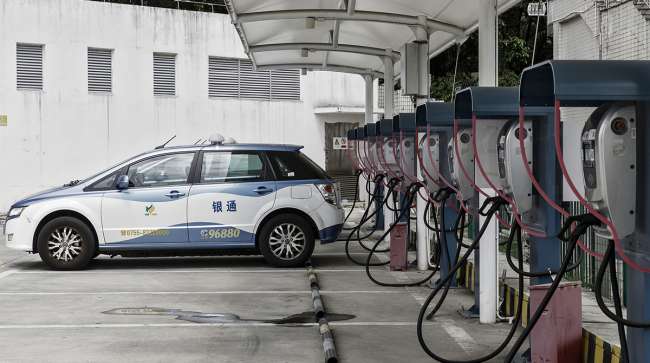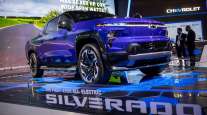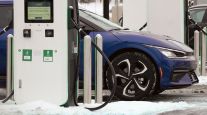China Beats US 8-1 When It Comes to Charging Electric Cars

[Stay on top of transportation news: Get TTNews in your inbox.]
There are almost as many places to charge your electric vehicle in Beijing as there are in the entire United States.
China, the world’s biggest market for EVs, has about eight public chargers for each one in the U.S., according to the latest counts. That imbalance likely will become more pronounced as China champions the technology spurring automakers to pivot away from gas guzzlers and accelerates its rollout of electric pumps, enlisting energy giants Royal Dutch Shell and BP along the way.
A new-energy vehicle development plan under consideration by Chinese officials and intended to shape the sector through 2035 will set new goals for boosting the number of public and private chargers, a person familiar with the proposal said in September. The nation is said to be weighing a target for 60% of all automobiles sold to run on electric motors by then.
All told, China’s electric fleet may swell to 162 million vehicles by 2040, according to forecasts by Bloomberg.
“The availability of charging facilities has been rising pretty quickly,” said Jing Kai, deputy head of the Beijing unit at Qingdao TGOOD Electric Co., which has the country’s largest network of charging plugs. “The goal is to help EV users charge their cars wherever they go, making it as easy as buying a bottle of water.”
The Great Charge Forward
China’s Ministry of Industry and Information Technology, which oversees policy making for the auto sector, didn’t respond to a faxed query.
EVs are essential to President Xi Jinping’s blueprint for creating a manufacturing superpower by 2025. The nation is building at least 20 “EV towns” for carmakers and ancillary industries, and it spent more than $30 billion subsidizing EV sales. China accounts for more than half of global EV sales.
U.S. automakers are moving at a slower pace, with Tesla Inc. generating most EV sales. The U.S. subsidizes some purchases, yet those benefits phase out, and Bloomberg forecasts sales will slump this year.
China had 466,101 public charging points by the end of last month, according to the China Electric Vehicle Charging Infrastructure Promotion Alliance. That includes more than 54,000 in Beijing.
By comparison, there were 60,652 electric nozzles in the U.S. as of June 25, according to Bloomberg. California has the most of any state with 19,000 — or about the same amount China adds in an average month.
With global EV sales forecast to rise to 56 million units by 2040, compared with about 2 million last year, there’s a need to vastly increase the number of publicly accessible chargers — not just to serve the expanding fleet but also to convince wavering consumers they can switch to electric models without fear of being stuck on the highway with an empty battery.

In our first episode of RoadSigns, Season Four, we ask: What Does the Future Hold for Truck Platooning? Hear a snippet from Cetin Mericli, CEO and Founder of Locomation, above, and get the full program by going to RoadSigns.TTNews.com.
As the speed of charging pumps increases, motorists increasingly are likely to refuel at workplaces, shopping malls or on the highway.
In the U.S., automakers such as Tesla and Volkswagen AG are leading the push to add chargers, including high-speed units. The number of points could surpass 400,000 by 2025, according to a forecast by Wood Mackenzie Ltd.
Provinces Power Ahead
Globally, as many as 20 million public charging points could be installed by 2030, the International Energy Agency forecasts.
Yet even in China, a nation with more chargers than any other, drivers still get frustrated trying to find a spot to juice up.
Tom He drives a 25-seater Nanjing Golden Dragon Bus Co. Skywell minivan to shuttle workers between home and workplaces in Beijing, and he can cover as many as 160 kilometers (99 miles) on a charge.
“It’s not that easy to find an EV charging place,” He said. “It drives people crazy when you can’t charge them.”
Costs also are a consideration, and it’s not uncommon to see EV owners lining up to use charging stations at night when electricity prices are lower, TGOOD’s Jing said. The company operates more than 131,000 connectors that fit almost all EV models in China, according to data compiled by Bloomberg.
“There’s still a long way to go and a lot of issues we need to crack,” Jing said.
Billions of dollars in government funding previously directed at lowering vehicle sticker prices now is being channeled, in part, toward expanding the number of charging stations, industry minister Miao Wei said in March. Some local authorities are offering incentives to lower construction costs for developers and to cut charging fees for consumers.
Miles Ahead
There’s a risk that China is rushing too fast to install chargers, especially since the overall car market recorded falling sales in 15 of the past 16 months. That’s contributing to fears the nation’s EV bubble is bursting.
Still, BP and Shell, among the energy industry’s biggest investors in cleaner technologies, are making moves to join China’s expansion.
London-based BP in August agreed to form a joint venture with ride-hailing company DiDi Chuxing Inc. The companies opened a pilot site in Guangzhou with 10 fast-charging units.
Shell, which has acquired two companies in the charging sector in the past two years, installed its first EV pump at a regular gas station in Tianjin.
China’s national rollout means some provinces have more chargers than European nations. The western province of Xinjiang has more public pumps than Turkey or Hungary, while Tibet has more than Belarus and Serbia, Bloomberg data shows.
“It’s a challenging job to become competitive in the charging equipment business, but we kept investing heavily in leading technologies,” TGOOD founder Yu Dexiang said. “Companies that fail to do these things in the future will be gradually eliminated.”
Want more news? Listen to today's daily briefing:




